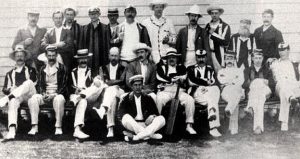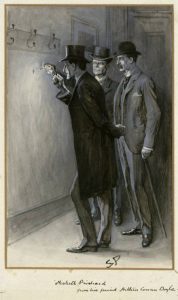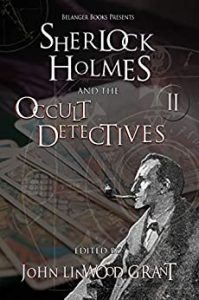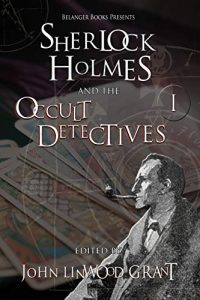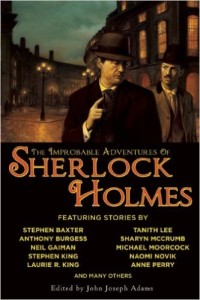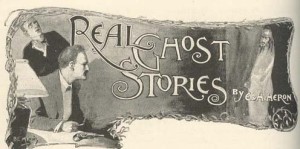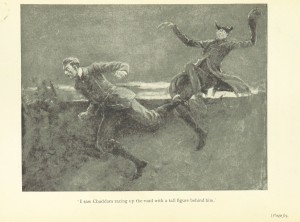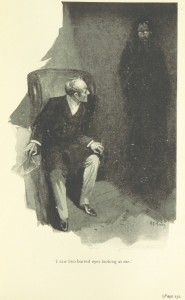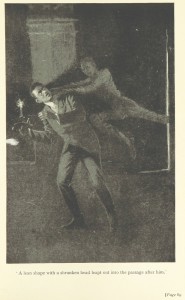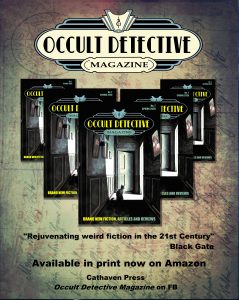Do you like Holmes, M R James, strange investigations, Victorian tales, and period drawings? Of course you do, so today, dear listener, we offer chaotic interconnections, as we recently found something online we rather liked. No, not chicken carcasses this time, but art by Sidney Paget, the great Holmes illustrator, gifted to the co-creator of detective Flaxman Low, writer Hesketh Prichard, by none other than Sir Arthur Conan Doyle!
For quick context, writer Hesketh Prichard (of whom we say much more later) was a friend of Conan Doyle, and a fellow member of the Authors Cricket Club, founded in 1892. You can see both of them in the photograph below:
Authors v Artists, May 1903: Authors in back row, left to right: E. W. Hornung (1st), E. V. Lucas (2nd), P. G. Wodehouse (3rd), J. C. Snaith (4th), A. C. Doyle (6th), H. V. Hesketh-Prichard (7th), A. Kinross (furthest right). Front row: S. F. Bullock (2nd from left), J. M. Barrie (3rd from right), G. C. Ives (2nd from right), A. E. W. Mason (sitting on ground).
J M Barrie and Conan Doyle both encouraged Hesketh Prichard to write fiction, and it seems that Conan Doyle gave at least two copies of Sidney Paget’s Holmes illustrations to his friend.
One was the plate “Is there any other point which I can make clear?” from the ‘The Adventure of the Naval Treaty’. The other is shown here, “Look at that with your magnifying glass, Mr. Holmes” from ‘The Adventure of the Norwood Builder’. Note the inscription…
Rather neat, we thought. And searching around, it seems that more details of the nature and whereabouts of Paget’s Holmes illustrations can be found here, on a site dedicated to tracing them: http://www.bestofsherlock.com/sidney-paget-original-art.htm
HOLMES AND THE WEIRD
Following those links, now to a tale which manages to include both Flaxman Low and Sherlock Holmes whilst at the same time following up on elements of an M R James story.
Some time back we delved into the issue of Sherlock Holmes pastiches and wilder re-imaginings of the Great Detective (see our article shades of sherlock). And we said that we ourselves liked and wrote straight, canonical Holmes adventures, but that sometimes a really well-written excursion into the supernatural could work.
Since then, old greydog has edited two chunky volumes of such stories for Belanger Books, Sherlock Holmes & the Occult Detectives, with tales which question or reinforce Holmes’s scepticism. Both volumes are out now, some 700pp of mystery and malevolence.
Anyway, back then, we also mentioned The Improbable Adventures of Sherlock Holmes (ed. John Joseph Adams, 2009), but had only dipped in and out of that anthology.
Afterwards, we came across this review, entirely by accident, on Goodreads:
The Things That Shall Come Upon Them (Barbara Roden)
“…this story should be taken as the model for Holmes-meets-Occult kind of adventures… But more importantly, in this story Sherlock Holmes does NOT do anything that goes against the canonical template of his thoughts & action, and the supernatural element is presented with its chilling moments and menace through the interpretations of the events as done by Flaxman Low… And the topping is that the story actually ties up a few loose ends in one of the greatest horror stories of all times (clue: the most-anthologised story by M.R. James).”
The tale was originally published in the Gaslight Grimoire anthology in 2008. In the introduction to it in Improbable Adventures, the author says:
“The story setting – Lufford Abbey – former home of Julian Karswell of M R James’s classic ‘Casting the Runes’ – came after I watched, with our son, the film version of ‘Casting the Runes’, Night of the Demon, and found myself wondering what happened to Karswell’s home after he died in somewhat mysterious circumstances, in France. The involvement of a ‘Dr Watson’ in James’s story was a gift from the writing gods.”
And here, for reference, is Dr Watson, from M R James’s text:
The conductor George was thoughtful, and appeared to be absorbed in calculations as to the number of passengers. On arriving at his house he found Dr Watson, his medical man, on his doorstep. ‘I’ve had to upset your household arrangements, I’m sorry to say, Dunning. Both your servants hors de combat. In fact, I’ve had to send them to the Nursing Home.’
‘Good heavens! what’s the matter?’
‘It’s something like ptomaine poisoning, I should think: you’ve not suffered yourself, I can see, or you wouldn’t be walking about. I think they’ll pull through all right.’
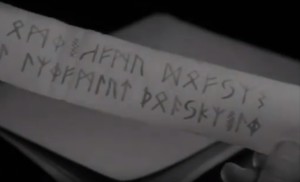
THE THAMES HORROR and Other Adventures of Sherlock Holmes, four of Barbara Roden’s Holmesian tales including the above, is also available from Amazon and Calabash Press:
Finally we travel from Arthur and Monty directly to Hesketh, and in relation to Paget’s work, consider some illustrations by B E Minns.
Benjamin Edwin Minns (1863 – 1937) was a leading Australian watercolorist, but from 1895 to 1915, he worked in England, contributing to St Paul’s Magazine, Punch, The Strand Magazine, the Bystander and other publications as well as sending drawings to The Bulletin.

(We can’t help feeling that Minns looks rather like M R James in the painting above)
As part of his work for London publishers, he produced a series of plates for Flaxman Low’s adventures in 1899…
HESKETH, VAYDOUX AND SLOTHS
We think it’s fair to say that if you are called Hesketh Vernon Hesketh-Prichard (1876-1922) and nicknamed ‘Hex’ at school, you ought to do something interesting with your life. The fascinating HVH-P did not let anyone down.
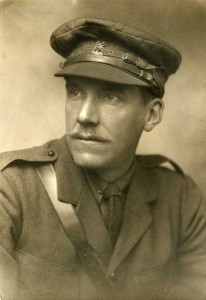
He hunted for (probably) extinct giant sloths in South America, helped counter German snipers on the Great War, played a mean game of cricket (as above), and explored the world. Through Trackless Labrador is one of his, for example, and he brought back some of the first reports of vodoun from the interior of Haiti. He could have been invented for the Boy’s Own Library.
In 1899, Prichard was the first white man to cross the interior of the black island republic since 1803, and he wrote a rather prejudiced book about it called Where Black Rules White. The nasty politics of the period (and basic humanity aside), it does include an interesting chapter on Vaydoux (voodoo, vodoun), where he describes practices he saw for his own eyes:
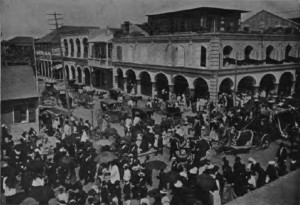
“As she danced she cleared her throat and spat with a noise like artillery coming into action. The huge black woman in the centre droned on, and to the drum-beat was added the chink of a key on metal. The Mamaloi quickened in her sinuous dancing. The heat was terrific; humanity sweltered there. And over all presided a portrait of the German Emperor, whose eye I seemed to catch at this juncture.
“The Papaloi, a small and filthy old man, crouched at one side, as the Mamaloi caught the cock from the hands of the big woman, and, holding it by the neck, flung it over her head and shoulder. Her face was distorted with frenzy; round and round she twisted, accompanied by a swifter measure of the same dead song. She laid the cock upon the heads of the worshippers and began to whirl more and more rapidly to the hurrying, maddening drumming. Suddenly she straightened her arm, spun the cock round and round, its flapping wings beating impotently upon the air. A snowstorm of feathers floated up as she stood with rapt eyes and bared teeth, twirling; then she flung up her hand, and the headless body flew over her shoulder.
“Her excitement was horrible; she pressed the bleeding neck to her lips, and, when she slowly withdrew her hand, stood for an instant fixed and immovable, her lips and teeth stained red.”
With his mother Kate O’Brien Ryall Prichard, ‘Hex’ wrote a series of occult detective stories. She also accompanied him on some of his travels, but that’s another matter…
THE FLAXMAN LOW STORIES
Warning: Occasional spoilers do follow.
M R James, said of the stories which follow:
“K and Hesketh Prichard’s ‘Flaxman Low’ is most ingenious and successful but rather over-technically ‘occult’”
The adventures of Flaxman Low were originally attributed to E and H Heron, possibly because the printers couldn’t fit both their full names on the covers. Published in 1898-99, there were twelve stories in total, stories which brought his character onto the occult detective roll of honour. These tales are interesting, unusual and come with a twist of the new science of psychology (these are the 1890s, remember). But wait…
We re-read the Heron family, and realised that this stuff is, in fact, frequently nuts. Enjoyable, but nuts. The detective himself is “one of the leading scientists of the day”, whose real name is not disclosed. He is also an accomplished sportsman, and a record-breaking hammer-thrower, strong and lean with a high forehead, long neck and thin moustache. We learn this early on, which gets us all a-quiver and ready for the horrors.
And boy did we have trouble picking which horrors to feature. So much gold in a shallow river. We have rarely felt so dumbfounded when we put a book down. Here are two of Flaxman Low’s encounters and discoveries, to give you the idea:
- A dead black servant found mouldering in a tiny cupboard after growing poisonous fungi, derived from deadly African spores, in there. Helpfully we are told: “how or why he made use of them are questions that can never be cleared up now”.
- A ghost which eventually turns into a vampire which decides to inhabit the remains of a recently-unwrapped Egyptian mummy. As an extra, the ghost/vampire/mummy may have come originally from an ancient barrow-mound. It’s like the entire Hammer Horror catalogue in twelve pages.
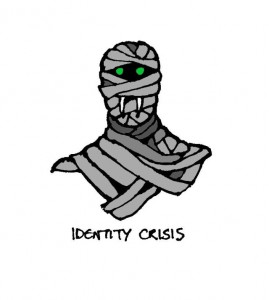 Flaxman Low the Man has a number of noble characteristics, apart from his high forehead. Firstly, he attributes almost everything to his advanced knowledge of psychology and study of psychic manifestations. When he can’t really answer someone’s question, he helpfully replies:
Flaxman Low the Man has a number of noble characteristics, apart from his high forehead. Firstly, he attributes almost everything to his advanced knowledge of psychology and study of psychic manifestations. When he can’t really answer someone’s question, he helpfully replies:
“Everybody who…. investigates the phenomena of spiritism will, sooner or later, meet in them some perplexing element, which is not to be explained by any of the ordinary theories. For reasons into which I need not now enter, this present case appears to me to be one of these.”
A wonderful paragraph, which in greydog’s humbler stories would have been rendered thus:
Inspector Chiltern: What was that, then?
Henry: Haven’t the faintest, old chap.
Secondly, he decides for quite unknown reasons to put everyone in danger (except himself) by declaring halfway through most stories that he has pretty much solved the case but won’t give them the answer until lots more harm has been done. We felt very Miss Marple sometimes, even at the end:
“But Aunt Jane, you still haven’t explained how the one-armed werewolf which killed Colonel Smythe knew that the spectral squid would be blamed…”
Thirdly, he likes burning/shooting/knocking things down as a quick end to the matter. If he had been written with a touch more Indiana Jones, the stories would be perfect. We have to commend to you the final scene with the barrow-wight/ghost/vampire/mummy, in which it is despatched by putting the bullet-riddled and beaten remains into a boat and giving them a Viking funeral. You couldn’t make this up – except the Heron family did.
There are tales in the collection which have genuine merit, but you have to pick and choose. To finish this piece we want to ruin one particular tale in more detail. The Story of the Spaniards, Hammersmith is the first Low appearance. It starts with the traditional motif of Flaxman Low being called in by a chum. The chum has inherited a house, and surprisingly, the house can’t be let for long because the tenants run away or shoot out the skirting boards. Financially embarrassed, the chum asks for help, and…
This story is wonderful, especially as it veers into Lovecraft before Lovecraft in its descriptions:
“The sensation he experienced as it moved was of some ponderous, pulpy body, not crawling or creeping, but spreading… then he became conscious of a pair of glassy eyes, with livid, everted lids, looking into his own… they were watery, like the eyes of a dead fish, and gleamed with a pale, internal lustre.”
This description follows the sighting of a bladder-like object regularly going into one of the rooms, but never there when pursued. “The bladder-like object may be the key to the mystery.” Low pronounces before any real investigation has started. There’s a detective for you.
It turns out that a leprous uncle who disappeared had died in the house, and is haunting it. Flaxman Low has a novel solution – they pull the house down. In doing so they find a malformed skeleton “under the boarding at an angle of the landing”. Low reveals that the uncle’s spirit has been intermittently animating the remains, at which point we kneel before Hesketh Vernon Hesketh Pritchard (and his mum) in awe.
You see, the bladder object was a bandaged, leprous foot, apparently visible when the rest of the body was not; marks on the sand-strewn landing were caused by walking sticks – lame ghost, apparently; the spirit had somehow become huge and pulpy despite animating a wrecked skeleton, and anyway, the leprous uncle who could hardly move had for some reason hidden himself ingeniously under the landing floorboards before he died.
We so get it. And there are many different versions of the collected tales available, new or second-hand, some of which only include six stories – look for the longer editions if you want to get all twelve.
The excellent blog site Skulls in the Stars has a nice summary of Flaxman Low, and it seems a shame not to quote that:
- Preferred tools: encyclopedic knowledge of the supernatural,
- incredible observational skills
- Opponents: malevolent spirits
- Success rate: Above average
- Affectations: Always has a theory, but hardly ever shares it
- Quotation: “Yet I can assure you that if you take the trouble to glance through the pages of the psychical periodicals you will find many statements at least as wonderful.”
Assessment: Low is a moderately good psychic investigator, though a relatively passive one. He allows skeptical and unprepared bystanders to accompany him on dangerous cases far too often. Furthermore, he is often slow to act, to such an extent that people often die before the problem gets resolved. Still, he knows his supernatural phenomena, and he generally puts an end to the troubling manifestations.
We applaud Skulls in the Stars, a site which manages to combine optics and physics with a love of classic pulp and horror. Such an animal suits our own lurcher-and-weird-fiction outlook. You can find it here: skulls in the stars
And there you have him, Flaxman Low, the occult detective with a difference. You really have been warned. For more on occult detctives in general, purchase a copy of Occult Detective Magazine, and see other pages here, or call in at Tim Prasil‘s site, which includes a very helpful chronology:
https://brombonesbooks.com/for-fun/the-chronological-bibliography-of-early-occult-detectives/
(Some of the above on the Flaxman Low tales appeared on this site in 2016)
More to come in the next few days. Subscribe for free (top left) to be alerted when we next venture out. No vampiric mummy barrow ghosts will call…
